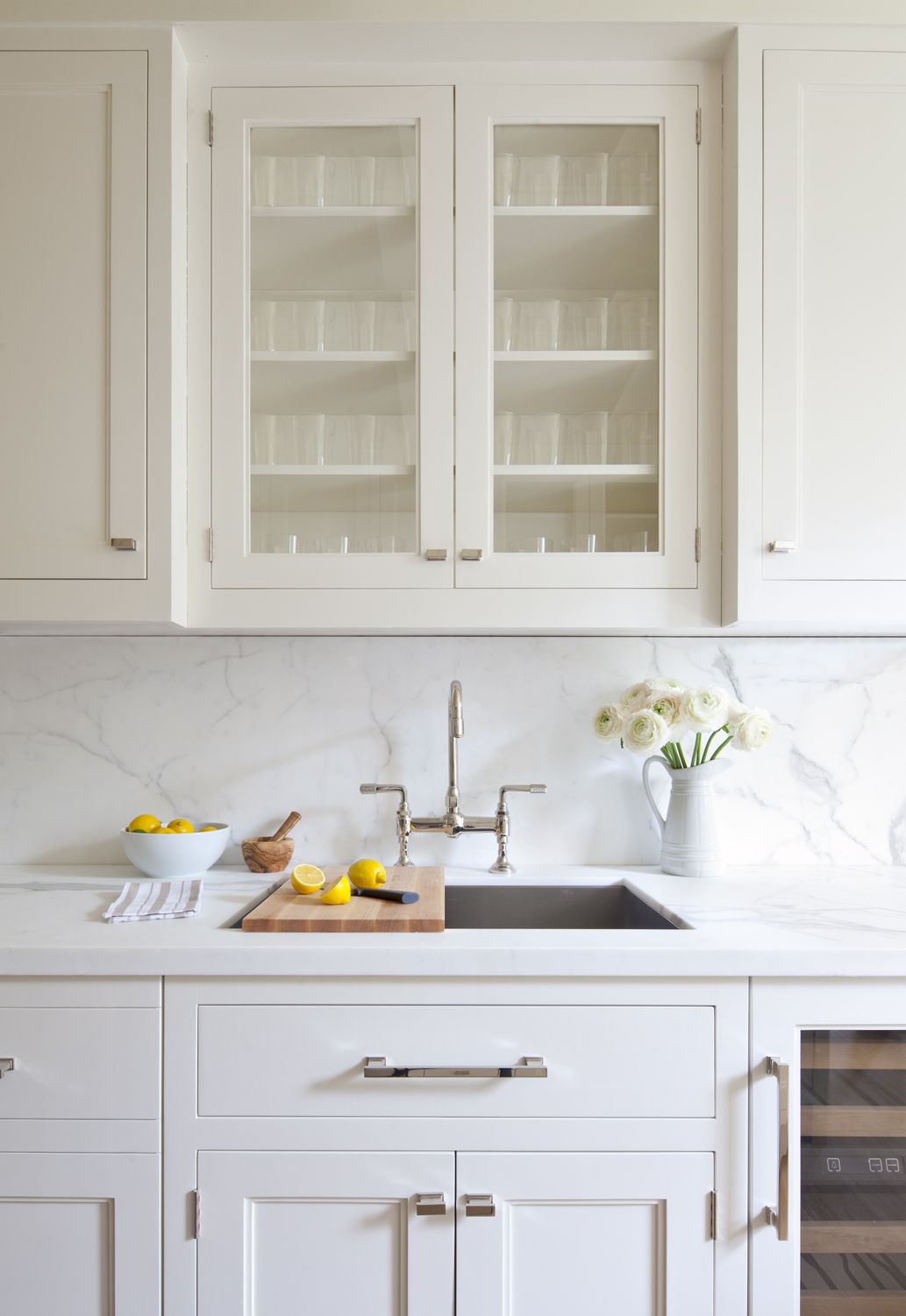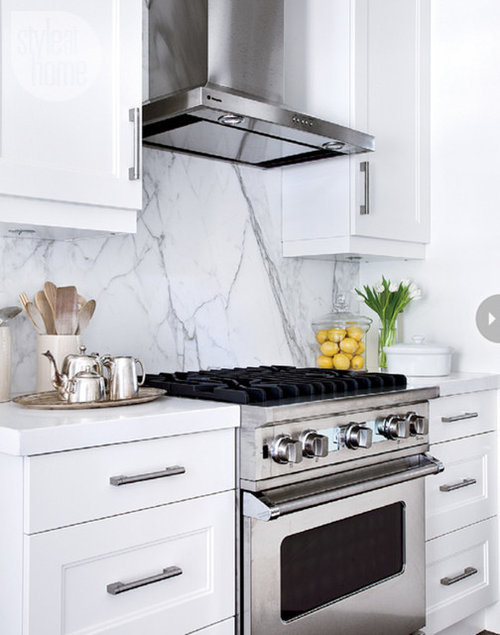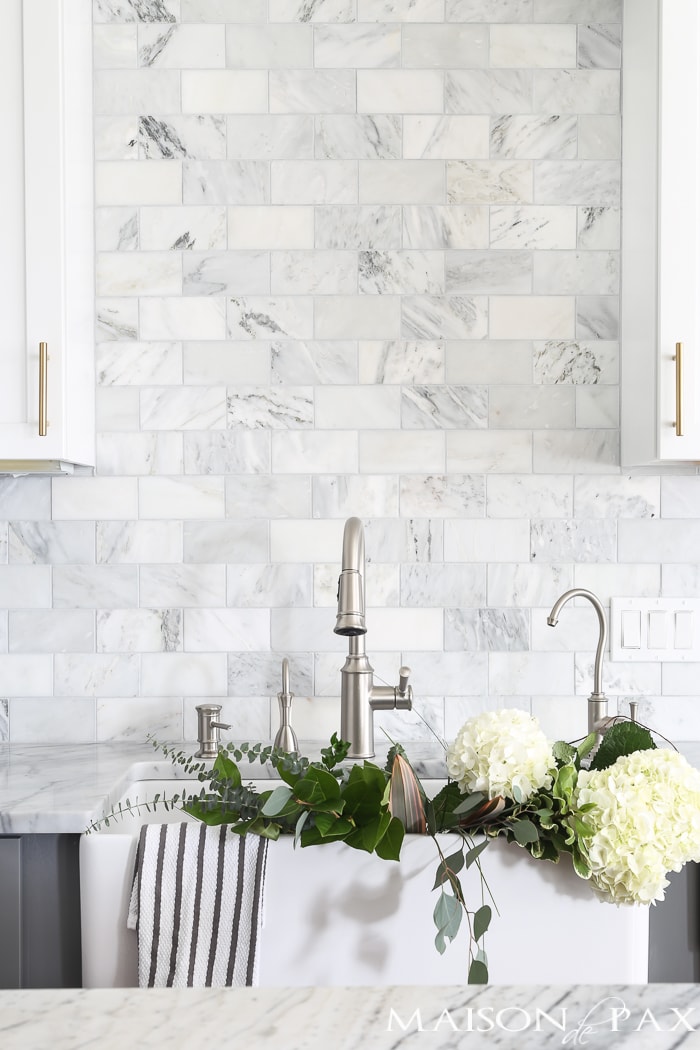Marble countertops have long been cherished for their timeless elegance and luxurious appeal. However, pairing them with the perfect backsplash can truly elevate the aesthetic of your kitchen space. Today we will discuss the world of marble countertop backsplashes, exploring their benefits, design options, installation process, and maintenance tips.
The Beauty of Marble Countertop Backsplashes
Marble countertops are renowned for their natural beauty, characterized by unique veining patterns and a luxurious sheen. When extended to the backsplash, this elegance is magnified, creating a cohesive and visually striking focal point in your kitchen. Whether you opt for classic white Carrara marble or the dramatic veining of Calacatta marble, the timeless allure of marble adds a touch of sophistication to any culinary space.
In addition to its aesthetic appeal, marble also offers practical benefits as a backsplash material. Its smooth surface makes it easy to clean, while its heat resistance ensures durability in a kitchen environment. Furthermore, marble’s reflective properties can enhance natural light, brightening the entire room and creating an airy ambiance.
However, it’s important to note that marble is a porous material and may require sealing to protect against stains and etching. Additionally, it is susceptible to scratching and may develop a patina over time, adding character to your kitchen.

Design Options and Customization
When it comes to designing your marble countertop backsplash, the options are virtually limitless. From classic subway tiles to intricate mosaic patterns, there’s a design to suit every style preference and kitchen aesthetic. For a cohesive look, you can match the marble used for your countertops with that of the backsplash, creating a seamless transition between the two surfaces.
Alternatively, you can play with contrasting materials to add visual interest to your kitchen design. Pairing marble countertops with a different backsplash material, such as glass or ceramic tiles, can create a striking juxtaposition that highlights the beauty of both materials. Additionally, you can experiment with different layouts, such as herringbone or chevron patterns, to add a touch of architectural flair to your kitchen space.
For those seeking a truly unique look, consider incorporating custom elements into your marble countertop backsplash design. Whether it’s a personalized mosaic mural or a custom-cut slab of marble, these bespoke touches can transform your kitchen into a one-of-a-kind masterpiece that reflects your style and personality.

Installation Process and Considerations
Installing a marble countertop backsplash requires careful planning and attention to detail to ensure a flawless result. The process typically begins with measuring and templating the area to determine the precise dimensions of the backsplash. This step is crucial for ensuring a perfect fit and seamless integration with the countertops.
Once the measurements are taken, the marble slabs or tiles are cut to size and prepared for installation. Depending on the complexity of the design, this may involve cutting intricate patterns or creating custom edge profiles to achieve the desired look. The backsplash is then carefully installed, taking care to align the seams and maintain a level surface throughout the process.
It’s important to hire a professional contractor with experience in working with marble to ensure a successful installation. Improper handling or cutting of the marble can result in costly mistakes and compromise the integrity of the backsplash. Additionally, proper sealing of the marble is essential to protect against staining and ensure longevity.
Maintenance Tips for Longevity
While marble countertops and backsplashes add undeniable beauty to your kitchen, they require proper maintenance to keep them looking their best. To prevent staining and etching, it’s recommended to seal the marble regularly with a high-quality impregnating sealer. This will create a protective barrier that repels moisture and prevents the absorption of liquids.
In addition to sealing, it’s important to clean your marble countertop backsplash regularly with a mild detergent and warm water. Avoid harsh chemicals and abrasive cleaners, as these can damage the surface of the marble and dull its natural luster. Instead, opt for gentle, non-abrasive cleaning products specifically formulated for use on natural stone surfaces.
To maintain the shine of your marble backsplash, periodically polish the surface with a marble-specific polish or polishing powder. This will help restore its natural sheen and keep it looking as good as new. Finally, be mindful of potential sources of damage, such as acidic foods and beverages, which can etch the surface of the marble if left unattended.

Common Mistakes to Avoid:
- Neglecting to seal the marble regularly, leaves it vulnerable to staining and etching.
- Using harsh chemicals or abrasive cleaners that can damage the surface of the marble.
- Failing to hire a professional contractor with experience in working with marble for installation, resulted in costly mistakes.
- Overlooking proper care and maintenance practices, leading to premature wear and dullness of the marble surface.
How do I prevent staining on my marble countertop backsplash?
To prevent staining, it’s important to seal the marble regularly with a high-quality impregnating sealer. This creates a protective barrier that repels moisture and prevents the absorption of liquids.
Can I use abrasive cleaners on my marble backsplash?
No, abrasive cleaners can damage the surface of the marble and dull its natural luster. It’s best to use gentle, non-abrasive cleaning products specifically formulated for use on natural stone surfaces.
What should I do if my marble backsplash develops scratches or etching?
Minor scratches and etching can often be buffed out using a marble-specific polish or polishing powder. For deeper scratches or etching, you may need to consult a professional stone restoration specialist for repair.
How often should I seal my marble countertop backsplash?
The frequency of sealing depends on factors such as usage and exposure to moisture. As a general rule of thumb, it’s recommended to seal your marble backsplash every 6 to 12 months to maintain optimal protection against staining and etching.
Can I install a marble backsplash myself, or should I hire a professional?
While DIY installation is possible for those with experience in working with natural stone, it’s recommended to hire a professional contractor with expertise in marble installation. This ensures a flawless result and minimizes the risk of costly mistakes.

Marble slab backsplash- Good or Bad Idea?

I like the back splash design Kitchen renovation, Home kitchens

Should you use marble in the kitchen? – Maison de Pax

Related articles:
- DIY Refinishing Cultured Marble Countertops
- Marble Countertops In Bathrooms
- Cultured Marble Countertops
- Gray Kitchen Cabinets Marble Countertops
- Modern Kitchen Marble Countertops
- Refinish Cultured Marble Countertop
- Carrara Marble Countertops Bathroom
- Marble Countertops Types
- How To Refinish Marble Countertops
- White Gray Marble Countertops